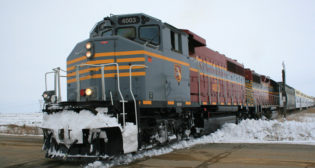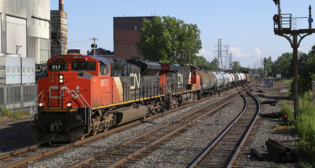
U.S. energy independence—with the railroad industry’s help
Written by William C. Vantuono, Editor-in-ChiefThe IEA, in its annual World Energy Outlook, has predicted that crude oil prices will rise to $128 a barrel by 2035, with a 16% increase in consumption supporting the development of “tight oil” (I suppose that means oil squeezed out of shale) in the U.S. and a tripling in output from Brazil. We most likely won’t be needing oil produced by OPEC (Organization of Petroleum Exporting Countries—remember the Arab oil embargo and resulting gas crisis of the early 1970s?), but OPEC may bounce back within the next 10-15 years “as other nations struggle to repeat North America’s success with exploiting shale deposits,” IEA has predicted.
“A number of more agile experts would say that the IEA is right about the role and importance of the U.S. in supply but for that very reason will be embarrassed by the continue decline in price ($80-90 range over the period),” a consultant told me. “The IEA is famous for lagging reality by a few years.”
IEA Executive Director Maria van der Hoeven and Chief Economist Fatih Birol spoke at a news conference in London about the organization’s world energy outlook, U.S. oil production, Brazil’s exports, and the role of the Middle East in the global supply chain, in a report written by Bloomberg’s Grant Smith:
“Soaring shale output in the U.S. is helping the world’s largest oil consumer achieve its highest level of energy independence in two decades, cushioning it against disruptions in Africa and the Middle East. The boom threatens revenues for OPEC’s 12 members (Algeria, Angola, Ecuador, Iran, Iraq, Kuwait, Libya, Nigeria, Qatar, Saudi Arabia, the United Arab Emirates, and Venezuela), whose production is at its lowest in two years amid political unrest in Libya and theft in Nigeria.
“U.S. oil production will rise to 11.6 million barrels a day in 2020, from 9.2 million in 2012, as it taps rock and shale layers in North Dakota and Texas with the use of horizontal drilling and hydraulic fracturing, according to the IEA. Over the same time period, Saudi Arabian production will fall to 10.6 million barrels from 11.7 million and Russia will slip to 10.4 million barrels from 10.7 million. The figures include natural gas liquids, condensates, and crude. U.S. output will plateau after 2020, and the nation will lose its top ranking at the start of the 2030s. ‘We do not expect this trend will continue after the 2020s,’ Fatih Birol said. ‘It will come to a plateau and decline as a result of the limited resource base of light tight oil.’
“Global oil demand will expand by 14 million barrels to average 101 million a day in 2035, according to the IEA report. The share of conventional crude will drop to 65 million barrels by the end of the period because of growth in unconventional supplies, the IEA said, without providing current data. The concentration in global oil trade will continue to shift to the Asia-Pacific region from the Atlantic Basin, as China is on the verge of becoming the world’s biggest oil importer, the report showed. India will displace China as the biggest driver of energy demand growth after 2020.
“‘The U.S. moves steadily toward meeting all of its energy needs from domestic resources by 2035,’ the IEA said. ‘But this does not mean that the world is on the cusp of a new era of oil abundance. Light, tight oil shakes the next 10 years, but leaves the longer term unstirred. The Middle East, the only large source of low-cost oil, remains at the center of the longer-term outlook.’”
A 10-year limit to the shale oil and gas boom? “Here also a number of more agile experts would say that the IEA is lagging reality in terms of the tremendous improvements in the productivity and effectiveness of shale extraction,” says the consultant I spoke with. “Thus the supposed short 10-year life of shale oil and gas is likley to be much, much longer.”
A Nov. 14 Cowen and Company roundtable provided insight into the regulatory requirements facing the tank car industry, the growing potential for oil drilling south of the border, and other key issues.
Could upcoming tank car regulations significantly impact the future of CBR? “New safety regulations could be drafted as early as Dec. 5, with potentially game-changing consequences for tank car manufacturers and strong ripple effects on the rail and energy industries, among others,” said Cowen and Company Managing Director and Railway Age Contributing Editor Jason Seidl. “Perhaps the worst-case scenario would be a mandate requiring retrofitting existing fleets with jacketing, a process the roundtable speakers seemed to agree is so costly, time-consuming, and complex that it would render much of the [existing] fleet almost obsolete.”
“The Mexican State-owned petroleum company Pemex has submitted tank car inquiries in the U.S., according to one of our speakers,” Seidl noted. “This is yet another sign that the Mexican government is getting closer to exploring likely oil reserves south of Texas. If production does occur at some point in that region, car manufacturers, and railroads such as Kansas City Southern and Union Pacific, would stand to benefit.”
Not only car manufacturers, but suppliers of components—wheels, trucks, couplers, draft gear, brake equipment, side bearings, etc.
But the rail industry itself appears to be looking to stay one step ahead of major regulatory changes regarding tank car safety. Today, the AAR released a statement in which it urged the U.S. Department of Transportation “to press for improved federal tank car regulations by requiring all tank cars used to transport flammable liquids to be retrofitted or phased out, and new cars built to more stringent standards.” AAR went as far as to spell out several changes in tank car construction, and expressed a desire to phase out older designs (such as the ones involved in the Lac Mégantic accident and a recent CBR train derailment in Alabama that fortunately did not result in any injuries or deaths).
Isn’t the railroads asking for more regulatory action a bit odd? Not where safety and risk mitigation are concerned. As an industry, if we’re going to take on additional hazmat traffic that, as a side benefit to developing a profitable line of business, will help the nation move toward energy self-sustainability and freedom from energy dependence upon politically unstable regions like the Middle East, we’re going to make sure we do it safely.



